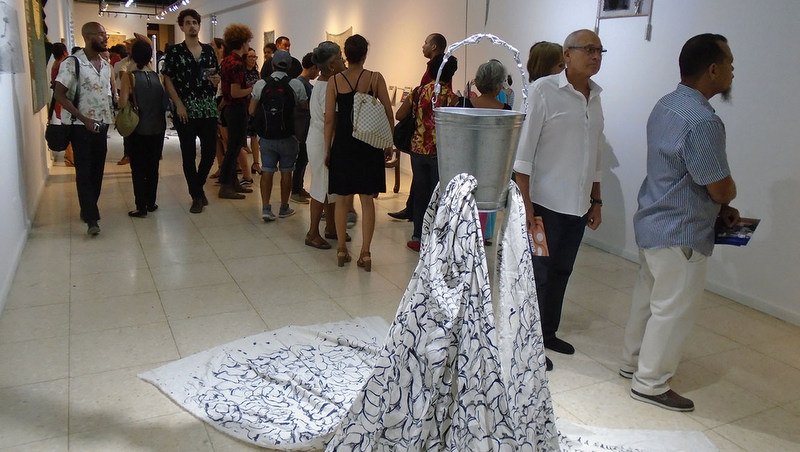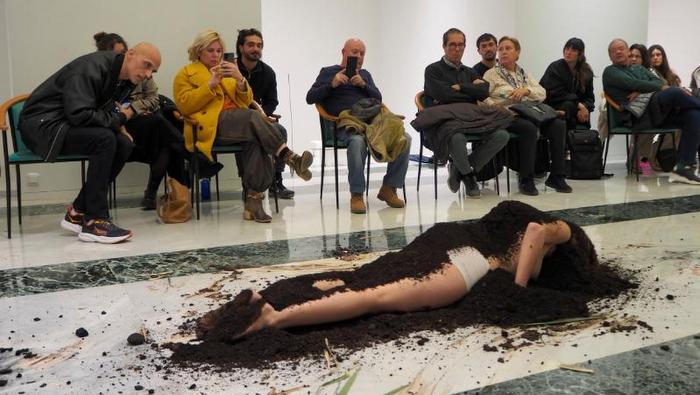An immense frame in the form of a screen. A table is filmed from above. In the manner of a conjurer, two gloved hands enter that show us quickly, and as if to indicate that there is no trap, the piece that in a few seconds, in the center of the representation, will be the victim of a hammer blow that will shatter it. The action is repeated for just over eleven minutes. The destroyed objects are part of a catalog of homemade ornaments of any Cuban home that could be included in that list of things manufactured as blood sausages and that we call kitsch. The funny thing is that as the massacre happens, they are drawing compositions that become ephemeral works of art, shaped by the remains of the pieces scattered on the table.
I just tried to describe it -better to see it (and hear it, because the sound of the hammer blows accentuates the "dramatism" of the executions) - the video work Restos (2006), one of the forty-something that the National Prize of Plastic Arts René Francisco exhibits at the Deuda exhibition, inaugurated at the La Acacia gallery - San José between Industria y Consulado, Centro Habana -, which will be open to the public until January 2019.
«Deuda is a personal exhibition of exception -Margarita Sánchez Prieto, an art critic and curator at the Wifredo Lam Contemporary Art Center, tells us in the catalog-. It is not intended to expose an area of the artist's recent production, or a new thematic line, or commissioned works; it is not a retrospective either. It is an exhibition of fragments of different moments of his artistic career that he wants to bring to light ". Although the show has a historical and comprehensive character, the artist did not conceive it from pieces that are found in collections and museums, but with what he keeps in his workshop, a place of creation and a kind of living museum of his work. René Francisco has rescued from the humidity and obliviousness pieces of early stages that were never shown to the public, and has made them participants in this initiative. He adds to this set known works, some forgotten, and segments that were iconic within their creation, belonging to different stages and speeches. Deuda is, therefore, a recount, a stop along the way ».
The exhibition covers an extensive period of three decades, ranging from the oldest, Automaltrato (cloth, sweat, 1988) and Art in America (oil, wood, glass, metal, 1989), pass by others as El apresado (battery of truck, lead wire, chains, cowbell, 1995) or Acerca del arte privado or El Principito (galvanized pipes, lead, paper, copper, 1996), and even some of the most recent: Límite (acrylic, metal, paper, 2016), Continuum (varied materials, 2018) and Matre (acrylic / cloth, 2018).
Arte por Excelencias spoke with two friends present at the show. Both agreed to give us their evaluations:
David Mateo (journalist, art critic and curator, founder of our magazine): «It is an emblematic exhibition. In this small space is condensed an important part of the history of a man who has been crucial in the development, in the concepts and in the path that Cuban art has taken in recent years. The exhibition demonstrates the coherence that has existed in the work of René Francisco, and the direct links he has had with specific stages through which he has traveled, including the reality of today. One looks at this exhibition and feels that works that are from the eighties can have perfect validity and invite reflection».
Jorge Ángel Hernández Pérez (poet, narrator and essayist, director of the publishing label Arte Cubano): «It is ostensible the rupture that he creates with the conceptualization, how he has been able to break the system and the norm of the art that is taking place in the surroundings, not only in Cuba, but in the rest of the world. He breaks them and creates new ideas and ways ».
From René Francisco himself - honorary doctorate in Fine Arts at the Art Institute of San Francisco, United States - we got the following words: «If David talks about coherence, it must be because my life has been coherent, and what is here is a self-portrait of my existence, my joys and my sorrows. Exhibiting in this gallery gives me a lot of pleasure, your staff is wonderful. What is happening with the cultural institutions is still critical, sometimes they do not deserve that the artists expose. They have to work with them, know that the country has great potential, that artists deserve a space. Here, surprisingly, is everything. My work reflects existential issues, some of them neuralgic with situations and political circumstances. This is my warehouse work, my family work ».















